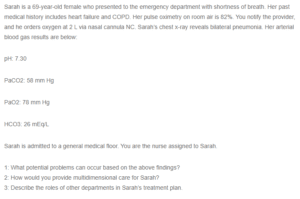Multidimensional Care for Sarah
Potential Problems
Based on the arterial blood gas results, Sarah has respiratory acidosis. Potential problems that can occur with respiratory acidosis are neurological damage, multiple organ dysfunction, and even death (Mendez et al., 2019). Neurological damage causes confusion, drowsiness, or loss of consciousness. Damage to the alveoli interferes with blood oxygenation, and heart rate increases to increase cardiac output. Sarah’s low oxygen saturation on room air and bilateral pneumonia on chest x-ray are indicative of respiratory failure. When the body is experiencing respiratory failure, it cannot properly oxygenate or eliminate carbon dioxide through the respiratory system. Respiratory failure can be further classified as hypoxemic or hypercapnic. In hypoxemic failure, there is no oxygen in the body. In hypercapnic, there is an excess of carbon dioxide.
Provision of Multidimensional Care
To provide multidimensional care for Sarah, I would need to monitor her oxygenation saturation and auscultate her lung sounds and vital signs regularly. I would also need to continue giving oxygen as ordered, administer antibiotics as prescribed, and monitor for adverse side effects of any of the medications. I would also educate Sarah and her family about her condition, danger signs to watch for, and self-care measures to improve her breathing, as Sandelowsky et al. (2019) note. Additionally, I would also need to coordinate with other healthcare team members, such as the primary care physician, respiratory therapist, and physical therapist. This will ensure that Sarah receives appropriate and timely high-quality care and treatment.
Roles of Other Departments
Other departments involved in Sarah’s treatment plan include respiratory therapy, physical therapy, primary care physician, pharmacy, and social work departments. The respiratory therapy department would administer respiratory treatments and monitor her lung function (Van Dijk et al., 2020). Next, the physical therapy department would help Sarah maintain mobility and perform exercises to improve her breathing. The pharmacy department would ensure that Sarah receives the correct medication and dosage. Additionally, the primary care physician would help coordinate Sarah’s care and order necessary tests or treatments. Social workers may also be involved in helping Sarah and her family with discharge planning.
References
Mendez, Y., Ochoa-Martinez, F. E., & Ambrosii, T. (2019). Chronic obstructive pulmonary disease and respiratory acidosis in the intensive care unit. Current Respiratory Medicine Reviews, 15(2), 79-89. https://doi.org/10.2174/1573398X15666181127141410.
Sandelowsky, H., Krakau, I., Modin, S., Ställberg, B., & Nager, A. (2019). COPD patients need more information about self-management: a cross-sectional study in Swedish primary care. Scandinavian Journal of Primary Health Care, 37(4), 459-467. https://doi.org/10.1080/02813432.2019.1684015.
van Dijk, M., Gan, C. T., Koster, T. D., Wijkstra, P. J., Slebos, D. J., Kerstjens, H. A., & Duiverman, M. L. (2020). Treatment of severe stable COPD: the multidimensional approach of treatable traits. ERJ Open Research, 6(3). https://doi.org/10.1183/23120541.00322-2019.
ORDER A PLAGIARISM-FREE PAPER HERE
We’ll write everything from scratch
Question
Sarah is a 69-year-old female who presented to the emergency department with shortness of breath. Her past medical history includes heart failure and COPD. Her pulse oximetry on room air is 82%. You notify the provider, and he orders oxygen at 2 L via nasal cannula NC. Sarah’s chest x-ray reveals bilateral pneumonia. Her arterial blood gas results are below:

Multidimensional Care for Sarah
pH: 7.30
PaCO2: 58 mm Hg
PaO2: 78 mm Hg
HCO3: 26 mEq/L
Sarah is admitted to a general medical floor. You are the nurse assigned to Sarah.
1: What potential problems can occur based on the above findings?
2: How would you provide multidimensional care for Sarah?
3: Describe the roles of other departments in Sarah’s treatment plan.

